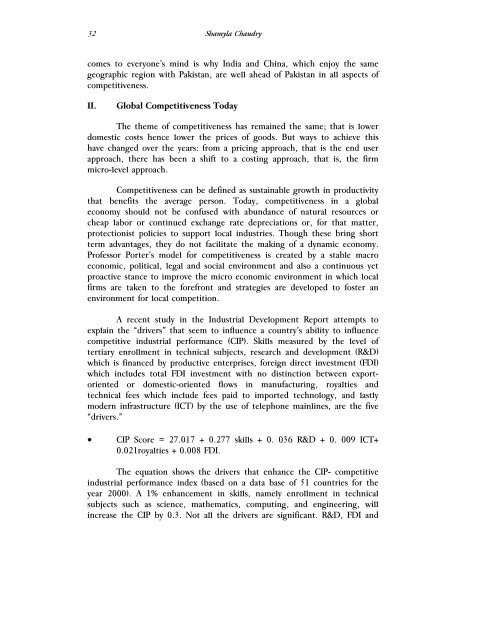Special Edition-07.pdf - Lahore School of Economics
Special Edition-07.pdf - Lahore School of Economics
Special Edition-07.pdf - Lahore School of Economics
Create successful ePaper yourself
Turn your PDF publications into a flip-book with our unique Google optimized e-Paper software.
32<br />
Shamyla Chaudry<br />
comes to everyone’s mind is why India and China, which enjoy the same<br />
geographic region with Pakistan, are well ahead <strong>of</strong> Pakistan in all aspects <strong>of</strong><br />
competitiveness.<br />
II.<br />
Global Competitiveness Today<br />
The theme <strong>of</strong> competitiveness has remained the same; that is lower<br />
domestic costs hence lower the prices <strong>of</strong> goods. But ways to achieve this<br />
have changed over the years: from a pricing approach, that is the end user<br />
approach, there has been a shift to a costing approach, that is, the firm<br />
micro-level approach.<br />
Competitiveness can be defined as sustainable growth in productivity<br />
that benefits the average person. Today, competitiveness in a global<br />
economy should not be confused with abundance <strong>of</strong> natural resources or<br />
cheap labor or continued exchange rate depreciations or, for that matter,<br />
protectionist policies to support local industries. Though these bring short<br />
term advantages, they do not facilitate the making <strong>of</strong> a dynamic economy.<br />
Pr<strong>of</strong>essor Porter’s model for competitiveness is created by a stable macro<br />
economic, political, legal and social environment and also a continuous yet<br />
proactive stance to improve the micro economic environment in which local<br />
firms are taken to the forefront and strategies are developed to foster an<br />
environment for local competition.<br />
A recent study in the Industrial Development Report attempts to<br />
explain the “drivers” that seem to influence a country’s ability to influence<br />
competitive industrial performance (CIP). Skills measured by the level <strong>of</strong><br />
tertiary enrollment in technical subjects, research and development (R&D)<br />
which is financed by productive enterprises, foreign direct investment (FDI)<br />
which includes total FDI investment with no distinction between exportoriented<br />
or domestic-oriented flows in manufacturing, royalties and<br />
technical fees which include fees paid to imported technology, and lastly<br />
modern infrastructure (ICT) by the use <strong>of</strong> telephone mainlines, are the five<br />
“drivers.”<br />
• CIP Score = 27.017 + 0.277 skills + 0. 036 R&D + 0. 009 ICT+<br />
0.021royalties + 0.008 FDI.<br />
The equation shows the drivers that enhance the CIP- competitive<br />
industrial performance index (based on a data base <strong>of</strong> 51 countries for the<br />
year 2000). A 1% enhancement in skills, namely enrollment in technical<br />
subjects such as science, mathematics, computing, and engineering, will<br />
increase the CIP by 0.3. Not all the drivers are significant. R&D, FDI and

















